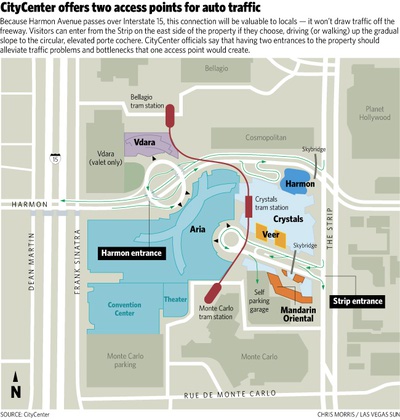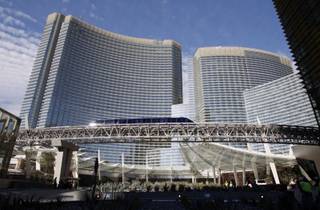
Steve Marcus / FILE
Work continues on the retail area of MGM Mirage’s CityCenter project on the Las Vegas Strip and Harmon Avenue in July.
Tuesday, Dec. 1, 2009 | 2 a.m.
Related Story
Jim Murren: CEO, MGM Mirage
Jim Murren, CEO of MGM Mirage, reflects on the beginning of CityCenter and what it will bring to Las Vegas.
Sun Archives
- CityCenter: One man’s concept of a real city (11-29-09)
CityCenter
For the motorist in Las Vegas for the first time, bumper-to-bumper traffic on the Strip can be a blessing because it allows more time for swivel-headed sightseeing. But most locals curse it as consistently the worst traffic jam in the county.
Now comes CityCenter, which will have thousands of employees and draw slews of visitors from its partial opening this week on.
So how much worse will all those people — and the attendant vehicles, taxis, limos and delivery trucks — make traffic in and around this section of the Strip? The massive $8.5 billion development is between Flamingo Road and Tropicana Avenue — roads where traffic is known to back up frequently.
CityCenter officials say they’ve done everything they can to improve traffic flow, and for locals who take some time to learn the shortcuts, getting in and out of the new development should be a breeze.
“We’ve been working on building in traffic solutions since Day One, and they have been included in the design,” said Gordon Absher, MGM Mirage’s vice president of public affairs.
Employee parking garages, for example, are off Frank Sinatra Drive, behind the resorts.
And with the opening of CityCenter comes the opening of the Harmon Avenue realignment, which now provides a new east-west alternative for motorists to get across the resort corridor.
Drivers may be skeptical at first when they see how the road winds through the narrow canyon created by CityCenter’s and the Cosmopolitan’s towers, but Harmon Avenue has long been considered a crucial part of traffic relief for the area.
“We know that traffic on the Strip is going to get really busy, and that’s not going to change. But we hope that having Harmon Avenue as an additional cross street besides Flamingo and Tropicana will help alleviate some of those other traffic (problems),” said Dave Betley of the county’s Development Services Department, which approves developments and their traffic studies.
The Harmon Avenue connection could prove particularly valuable to locals because, like the Desert Inn Super Arterial, it does not connect to Interstate 15, meaning there will be less tourist traffic on the road.
But unlike Desert Inn, Harmon Avenue intersects Las Vegas Boulevard. And, the street doesn’t continue very far on either side of the Strip.
The route through CityCenter connects the two segments of Harmon that previously stopped at Las Vegas Boulevard then resumed on the other side of I-15; however, the road breaks again a short distance west of the freeway where it and Valley View Boulevard meet the railroad tracks.
On the east side of the Strip, Harmon dead-ends where it meets UNLV, but only after providing connections to Paradise Road and Swenson Street, which carry traffic to and from McCarran International Airport.
The county has plans to connect Harmon and Valley View Boulevard at the railroad tracks, but that project is up in the air.
“That Harmon project is extremely dependent on the economy, the tax base and if the funding is going to be there in a year or so,” Betley said.
In the meantime, for locals who want to get to CityCenter, Harmon Avenue is still the best bet, officials say.
Harmon provides direct access to the development, a feature mimicking those of resorts such as the Bellagio and the Mirage, which have a north-side valet entrance for locals who don’t want to drive on the Strip, Absher said. But this is on a much larger scale.
“We’ve taken a good idea from previous resorts and expanded on it by giving CityCenter a second access point,” he said. “We’re not funneling everybody to one place, we’re giving people a choice.”
And the larger second entrance means locals don’t have to keep it a secret.
“We have the insider entrance, but now you don’t have to be afraid to tell your friends from out of town,” Absher said.
The access point off Harmon Avenue, called Harmon Circle, is the first elevated porte-cochere in North America, Absher said. Motorists will take a ramp up from Harmon Avenue to the circle, which will then take them to a valet area at Aria on the south side of Harmon, or a valet at Vdara, on the other side of Harmon.
There will still be a traffic signal on Harmon Avenue where the pickup area for Aria and the on-site Clark County Fire Station are, but the elevated circle will keep traffic from backing up on the main road.
The county planned and built the Harmon bridge over I-15 before CityCenter began in an effort to bring relief to traffic around the Strip.
“We wanted to make sure they were still going to be able to accomplish that and keep traffic as free-flowing as possible,” Absher said.
In addition to access from Harmon, CityCenter has a main drive off Las Vegas Boulevard, called CityCenter Place. The driveway is designed to offer access to the heart of the complex without traffic lights slowing down the flow.
Ramps from the main driveway provide access to valet parking for Mandarin Oriental, Veer Towers, Aria and the Crystals shopping district. Plus, the drive is the only way to access the complex’s single self-parking garage, which is between Mandarin Oriental and Aria.
While the developers say there is more parking at the facility than is required by the county, the design clearly encourages visitors to use one of the complex’s seven valet facilities rather than the one self-park garage.
“That’s important to the type of customers we’re bringing in — even the locals are going to want to use the valet,” Absher said. “We have a self-parking garage, but the insider, the smart local, may choose to avoid Las Vegas Boulevard, which is where you have to access the self-park garage from.”
For those that don’t want to hassle with CityCenter’s driveway but still want to self-park, they can drive to the self-park garages at the Bellagio or Monte Carlo and take the tram to CityCenter.
For people who don’t want to drive, CityCenter will offer a bike valet service and easy access to two bus stops.
Those bus stops will be especially important when the Regional Transportation Commission begins service next March of its ACE Gold Line, which will connect downtown to the Convention Center and the Strip.
Currently, the RTC’s Deuce buses carry 33,000 passengers a day through the area. When the ACE line begins service, the two lines together are expected to be capable of carrying 45,000 to 50,000 people each day.
Once the ACE line begins and locals are comfortable using Harmon, traffic on the Strip should not be much different from now, Absher says.
In the meantime, local officials will continue to make adjustments to try to keep traffic flowing through the CityCenter area. The RTC’s Freeway and Arterial System of Transportation, or FAST center, coordinates traffic signals, freeway ramp meters and message signs using cameras overlooking major roads throughout the valley.
“We won’t set the signals one way at opening day and then leave them at that,” spokeswoman Tracy Bower said.



Join the Discussion:
Check this out for a full explanation of our conversion to the LiveFyre commenting system and instructions on how to sign up for an account.
Full comments policy